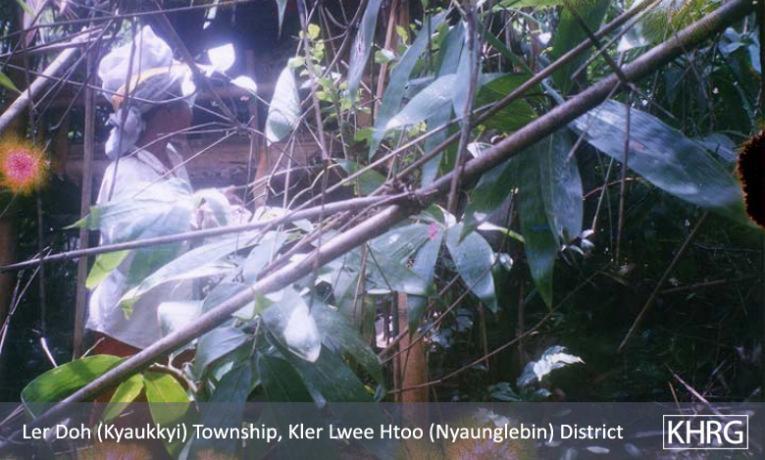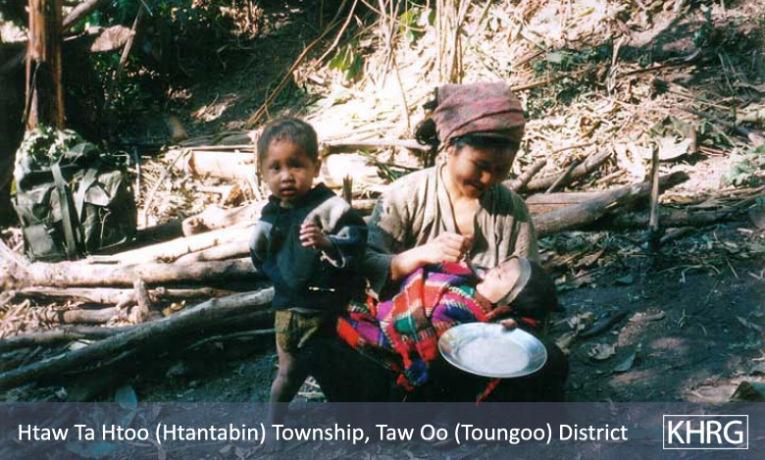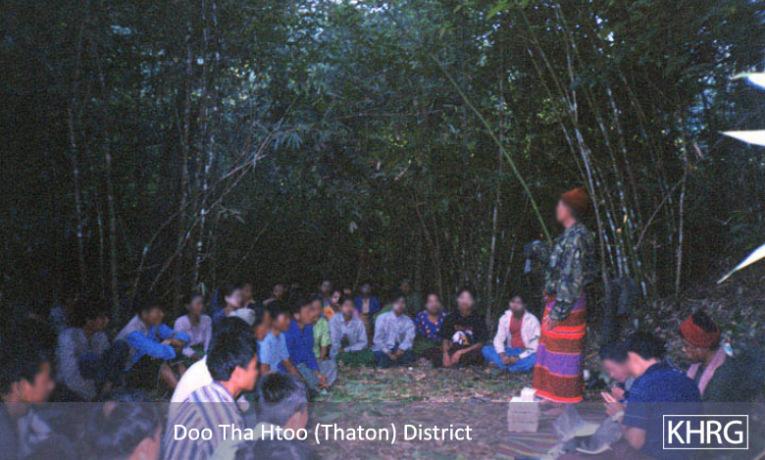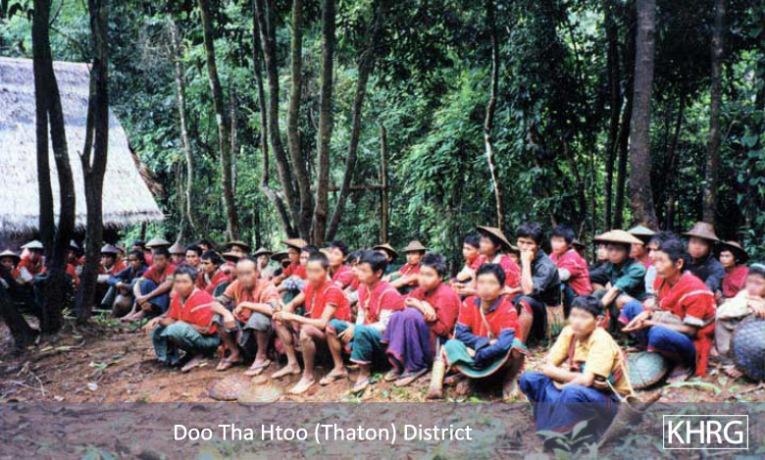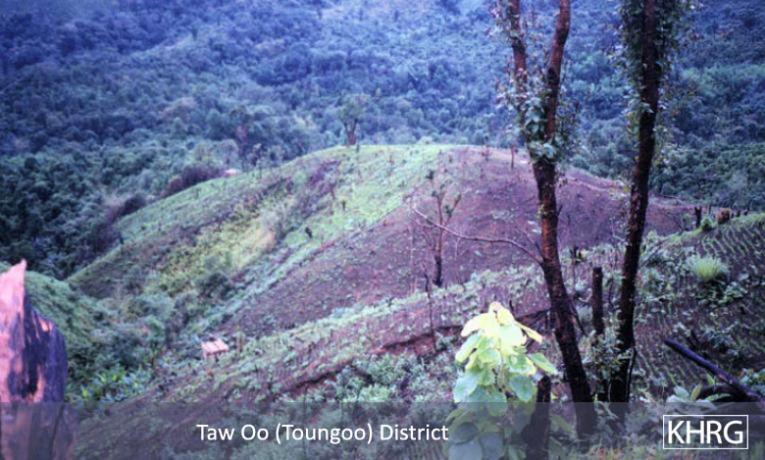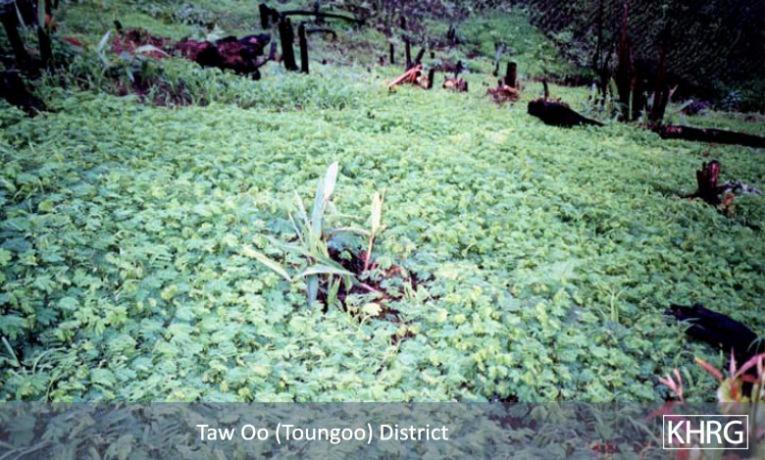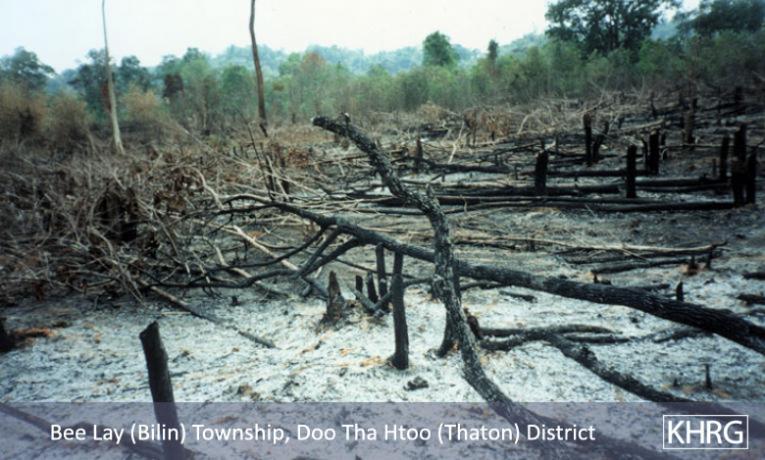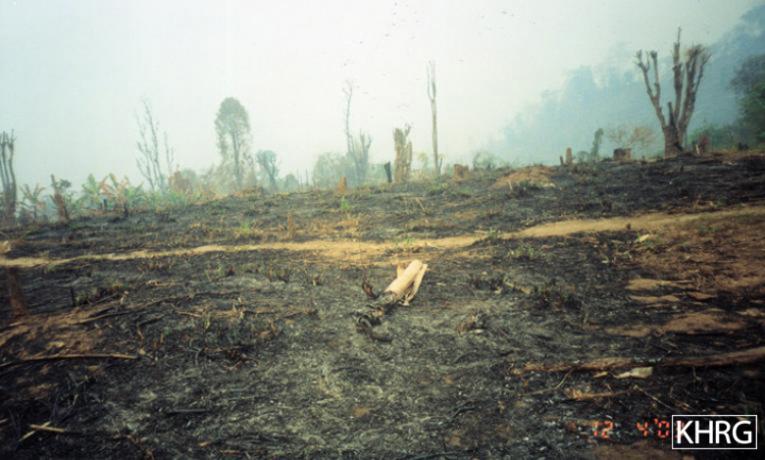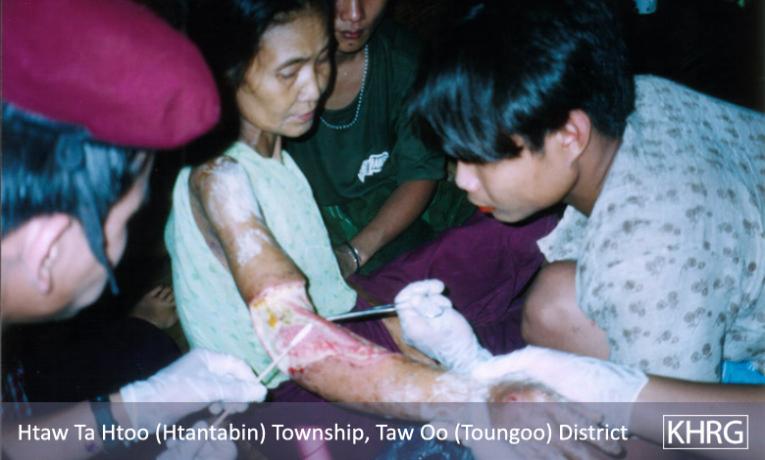Photos #1-44, 1-45, 1-46, 1-47, 1-48, 1-49, 1-50, 1-51: Despite the efforts of SPDC columns to destroy the food supplies, in December 2004 displaced villagers from the Khaw Hta / Yah Aw area in Shwegyin township were already risking encounters with SPDC patrols by returning to salvage what they could of their paddy. Photo 1-44 shows a Khaw Hta villager's partly-completed harvest, already threshed into the grain (left) and the straw (right) but left behind when she fled the SPDC column. Others had already returned to see what they could retrieve; in photo 1-45 , villager T--- sifts through his uncle's burned paddy storage barn to see how much grain he can salvage. Photo 1-46 shows K--- looking at all he could salvage from his burned paddy, only enough to survive on for a few weeks. Photo 1-47 shows the farmfield hut of Saw K---; SPDC soldiers set it alight but it didn't burn, leaving much of the harvested paddy intact. Photo 1-48 shows Saw N---, 28, returning to the forest with a basket of paddy he managed to salvage from his hut. In photos 1-49 through 1-51 , children play among the paddy they have safely brought back to the forest after helping their parents recover it. Photo 1-51 is a foot-operated pounder used to dehusk the paddy; this one of bamboo and wood was quickly built by Yah Aw villagers displaced in the forest. All of these photos were taken between December 6 th and 15 th 2004. [Photos: KHRG researcher]
Photo #6-133: A stretch of the Toungoo – Mawchi vehicle road in Tantabin township of Toungoo District as it appeared in January 2004 (see map ). Once the SPDC had completed construction on the Kler Lah – Bu Sah Kee road in 1998, they focused their attention on repairing the 150 kilometre (96 mile) long old colonial road from Kler Lah to Mawchi in Karenni State. The reconstruction work, conducted largely by forced labour, was completed in 2002. In early 2003, the SPDC established a number of new permanent Army Army camps along the road at Wa Baw Day, Kler Htoo Day, and Ler Wah Mu Thwa Koh to give them a better foothold in the region. The SPDC used this road to move troops and supplies through the area during its 2003-2004 offensive against the Karenni National Progressive Party (KNPP) and the simultaneous forced relocation campaign against the villagers in southern Karenni State. Not only does this road provide the SPDC with increased military access allowing for the rapid mobilisation of troops into southeastern Toungoo District, it effectively cuts the district in two, with the camps and patrols along its path creating a substantial barrier against movement – blocking the supply lines to KNLA forces in Than Daung township and the flight of villagers in either direction. Villagers and IDPs in the area of the road no longer dare to travel to their fields for fear of being seen by an SPDC patrol, further exacerbating the already serious problem of food scarcity, and most people from villages along the road route have had to flee either northward or southward into the hills. [Photo: KHRG researcher]
Photo #7-37: Shortly after the internally displaced villagers from T--- village in Tantabin Township of Toungoo District cut and cleared this hill field in early 2004, a small unit of troops from LIB #660 built a temporary outpost just a few minutes' walk away – possibly with the purpose of locating and catching the IDPs who cleared the field. The villagers, however, stayed away once the post was there, and were never able to plant this field. This photo was taken in August 2004, when it was already too late to plant. This illustrates the difficulties and uncertainties IDPs face in growing rice; if an SPDC unit loiters nearby at any time during the crop cycle, the entire crop is lost. [Photo: KHRG researcher] Photo #10-139: Naw P---, an internally displaced villager in Kyauk Kyi township, Nyaunglebin District, is shown here arriving at her rice storage barn at T--- village on May 12 th 2004 only to find it already destroyed by SPDC LIB #388. Displaced villagers keep rice in hidden storage barns and periodically return to get food supplies, but SPDC columns systematically hunt out and destroy these storage sites. [Photo: KHRG researcher]
Photo #10-140: Naw T--- from T--- village, Tantabin township, Toungoo district, puts together a meal in the forest for her children after fleeing her village in February 2004 to escape abuses by LIB #117, which controls her area. Photo #10-141: A mother feeds her baby some rice porridge in the forest after fleeing her village in Tantabin township, Toungoo district, in January 2004 due to SPDC military activity. Thin rice porridge is not only a food for babies, it is also a way that IDPs make their meagre rice supplies last longer. [Photo: KHRG researcher]
Photos # 7-85, 7-86, 7-87: Karen relief teams meeting with internally displaced villagers in the forests. Photo 7-85 was taken in Thaton District in April 2004, photo 7-86 in Thaton District in November 2003, and photo 7-87 in Papun District in September 2003. Relief teams such as this operate on only very limited budgets themselves and must travel great distances at considerable risk into the areas where IDPs are hiding to provide them with what aid they can. Note the stacks of Kyat notes at the feet of the man standing on the right in photo 7-86 addressing the group. Each villager at these meetings was given 4,000 Kyat with which to buy rice to feed their families. This money, however, is usually only enough to buy about two months worth of rice. Relief organisations such as this one are usually able to provide the villagers in some areas across Karen State with this sort of emergency support once every six months, but they remain under-resourced and cannot reach the majority of IDPs on a regular basis. As helpful as this aid is, it can only reach a small proportion of the ever-growing numbers of internally displaced villagers currently in Karen regions. [Photo: KHRG researcher]
Photo #9-8: Displaced in January 2004 by SPDC LIB #117 forces militarising the area around the Toungoo-Mawchi vehicle road and trying to flush Karen and displaced Karenni villagers out of the hills, these Karen children from T--- village in Toungoo District wait in their hiding site in the forest for their parents to return from foraging for food. [Photo: KHRG researcher]
Photos #11-20, 11-21, 11-22, 11-23, 11-24: Early on the morning of December 30 th 2003, SPDC soldiers from Light Infantry Division #55 found and burned a paddy storage barn containing approximately 100 baskets [2,500 kgs. / 5,500 lbs.] of paddy which displaced villagers had hidden near K--- village in Lu Thaw township, Papun district. Later that morning some villagers went to the site to see what rice they could salvage, accompanied for protection by 18-year-old Saw S--- from M--- village, who is a member of the KNU's Karen National Defence Organisation (KNDO) militia. When they reached the destroyed paddy barn at 11:45 a.m., Saw S--- stepped on a landmine the SPDC soldiers had planted there before leaving, presumably to kill anyone who came back for the rice. The mine blew off Saw S---'s right foot and mangled his left leg. Photo 11-20 shows all that remained of his right shoe after the blast. Photos 11-21 through 11-23 were taken as he received treatment from a mobile team of Karen medics a week later on January 8 th 2004. In Photo 11-24 , one of the medics displays just one of the pieces of shrapnel removed from Saw S---'s leg. [ Photos: KHRG researcher]
Photo #7-17: This pile of ash and charred paddy is all that remains of a rice storage barn near the IDP hiding site at K--- in Lu Thaw township, Papun District. Soldiers from SPDC Light Infantry Division #55 burned it on December 30 th 2003 as their forces swept through the area in search of IDPs and their food supplies. This photo was taken in January 2004. [Photo: KHRG researcher] Photos # 7-85, 7-86, 7-87: Karen relief teams meeting with internally displaced villagers in the forests. Photo 7-85 was taken in Thaton District in April 2004, photo 7-86 in Thaton District in November 2003, and photo 7-87 in Papun District in September 2003. Relief teams such as this operate on only very limited budgets themselves and must travel great distances at considerable risk into the areas where IDPs are hiding to provide them with what aid they can. Note the stacks of Kyat notes at the feet of the man standing on the right in photo 7-86 addressing the group. Each villager at these meetings was given 4,000 Kyat with which to buy rice to feed their families. This money, however, is usually only enough to buy about two months worth of rice. Relief organisations such as this one are usually able to provide the villagers in some areas across Karen State with this sort of emergency support once every six months, but they remain under-resourced and cannot reach the majority of IDPs on a regular basis. As helpful as this aid is, it can only reach a small proportion of the ever-growing numbers of internally displaced villagers currently in Karen regions. [Photo: KHRG researcher]
Photo #7-18: These are the chopped-off stalks of betelnut trees, whose fruit is a major cash crop in Karen regions. This plantation belonging to Saw B---, 36, from K--- village in Mone township of Nyaunglebin District was cut down by soldiers from SPDC LIB #20 in August 2003. Betelnut trees can take as long as a decade to become productive and bear fruit. SPDC troops in the area cut them down to cut off hill villagers' access to cash and food in hopes that this will force them to move to SPDC-controlled villages. This photo was taken in November 2003. [Photo: KHRG researcher]
Photos # 7-55, 7-56, 7-57: These photos show villagers from Mone township, Nyaunglebin District buying food and dry goods at a secret 'jungle market' where the villagers from the plains and SPDC-controlled villages can sell their goods to villagers and IDPs from the hills. In many areas across Karen State, the SPDC has prohibited trade between those who live in the plains and those who live in the hills, in an attempt to make survival unsustainable for IDPs and resistance forces. Unable to grow enough rice because ricefields are too visible to SPDC patrols, many internally displaced villagers have switched to small-scale forest cash crops like cardamom which they can then sell to buy rice; but they cannot dare enter SPDC-controlled villages to exchange their crops for fear of capture. 'Markets' such as this one are occasional, shifting and temporary and must be established with the utmost secrecy. If SPDC authorities were to find one of these markets, all of the villagers in attendance would be accused of being KNU sympathisers, and would be detained and possibly tortured or summarily executed. In photo 7-57 , a few KNLA soldiers are also buying goods. These photos were taken in October 2003. [Photos: KHRG researcher]
Photo #7-39: This is the hill field of Saw M---, age 43, from T--- village in Lu Thaw township of Papun District. After using 21 baskets of rice seed to plant this field, he had to flee his village with his family of ten due to increasing SPDC activity in the area. They are now internally displaced at D--- and dare not return to tend the field, so this entire crop will be lost. This photo was taken in October 2003. [Photo: KHRG researcher] Photos #7-40, 7-41: Villagers from Wa Soe and Sho Ser villages, along the Toungoo-Mawchi road route in eastern Toungoo District ( see map ), fled their villages en masse when SPDC forces established a number of new military camps nearby in conjunction with their reconstruction of the Toungoo-Mawchi vehicle road. Shortly after being cleared and planted, these hill fields were abandoned early in growing season because the villagers feared being seen and shot or abused by soldiers moving along the newly reconstructed road. These photos were taken in June 2003. [Photos: KHRG researcher]
Photos #5-23, 5-24, 5-25: Saw Pa Kyaw Dah, age 38, from N--- village in Papun District was shot dead by soldiers from SPDC Light Infantry Division #66 on May 29 th 2003. He was working in his hill field planting the paddy seeds for the next harvest when he was spotted and shot on sight. The SPDC is trying to clear villagers out of the hills where he lives, and Army columns often target villagers as they are working in their hill fields where they are far more visible. These photos were taken the day after he was killed. [Photos: KHRG researcher]
Photos # 7-20, 7-21, 7-22, 7-23: These hill fields were prematurely burned by SPDC soldiers in 2003 to prevent villagers being able to plant a proper crop. Before a hill field can be planted, any brush that has grown since it was last used needs to be cut down, dried, and then burned. The burning is normally conducted in April or May once the cut scrub has sufficiently dried out. Burning prematurely produces an uneven burn, leaving clutter of bushes and small trees which makes a complete planting impossible. Without being able to plant the entire field, the villagers are unable to get enough rice to last them until the next harvest. Photos 7-20 and 7-21 show hill fields in Bilin township, Thaton District, prematurely burned on April 3 rd 2003 by SPDC LIB #11 (Battalion Commander Thein Zaw commanding). Photos 7-22 and 7-23 show hill fields near Ho Kay village, Bu Tho township, Papun District, prematurely burned on March 4 th 2003 by SPDC soldiers from LIB #6 and IB #14 (Battalion Commander Thein Htun commanding). These photos were taken in April 2003. [Photos: KHRG researchers] Photos #7-24, 7-25: SPDC Army soldiers destroyed this paddy barn near P--- village in Papun District in mid-2003. Almost all of the 50 baskets [1,050 kgs. / 2,300 lbs.] of paddy that were inside the barn were rendered inedible after the soldiers poured it on the ground. The owner of the barn, internally displaced villager Saw T---, was only able to salvage four or five baskets [84-105 kgs. / 184-230 lbs.] of the paddy. Once processed into edible rice, this will only last his family of six for one to two months. [Photos: KHRG researcher] Photos # 7-27, 7-28, 7-29: This is all that remains of the paddy storage barn belonging to Saw K---, 25, and Naw R---, 45, from Saw Mu Plaw village tract in Papun District. It was burned by SPDC troops on January 4 th 2003, destroying 60 baskets [1,260 kgs. / 2,760 lbs.] of paddy as well as their large ceramic jar, machetes, a spade and a saw. The paddy was still smouldering when these photos were taken a week later. [Photos: KHRG researcher]
Photo #7-44: Internally displaced women from P--- village in Bu Tho township, Papun District drying their cardamom harvest in January 2003 prior to taking it to market for sale. For IDPs living in hiding to avoid SPDC Army control, growing large fields of rice is too dangerous so they have to grow small-scale cash crops which they can sell to buy rice. Photos #7-61, 7-62: Villagers from M--- village work together to finish harvesting ricefields in Bu Tho township of Papun District even though SPDC soldiers are based nearby at T---. In this area villagers are often shot on sight, so the work must be completed quickly. Villagers are exposed and vulnerable in the fields, and SPDC troops often set ambushes by the fields at harvest time to capture or kill IDPs (as can be seen in Section 5, Shootings and Killings ). These photos were taken in November 2002. [Photos: KHRG researcher]
Photos #7-59, 7-60: In 1997 the SPDC forcibly relocated the villagers from Meh Kaw Law village to the Meh Way relocation site in Dweh Loh township of Papun District. Once they were relocated, the SPDC Army soldiers would not allow the villagers to return home to work these fields, fearing that they would go into hiding in the hills. These photos, taken in December 2002 and June 2003 respectively, demonstrate the progressive degeneration of unused ricefields, as the dikes erode and the fields silt up and become overgrown. These fields would now need major work before being usable again. [Photos: KHRG researcher]
Photos #5-31, 5-33: On November 4 th 2002, Saw L---, Saw P---, and Saw Sha Kaw from D--- village in Lu Thaw township, Papun District left their village to sell bamboo that they had cut. They were spotted by soldiers from SPDC IB #19 who opened fire on them, wounding Saw L--- and killing Saw Sha Kaw. Photo 5-31 shows 27 year old Saw L--- receiving medical attention for the gunshot wounds in his shoulder at a KNU clinic in the area. Photo 5-33 is of Saw Sha Kaw's wife and four children. With her children still too small to do much hard work in the hill fields, it will be difficult for her to grow enough food for her family. SPDC forces routinely shoot villagers on sight in this area, because they have never been able to bring it under their full control. [Photos: KHRG researcher]
Photos #5-33, 5-34, 5-35, 5-36, 5-37, 5-38, 5-39, 5-40: On October 30 th 2002, a number of villagers from S--- village in northern Lu Thaw township, Papun District, went to harvest the paddy from their hill field at T---. SPDC forces have been trying to depopulate this hill area since 1997 by destroying villages, crops and food supplies and shooting villagers on sight, but thousands of villagers still survive here. At 3:30 pm as the villagers were collecting their harvest, soldiers from LIB #235 crept up on them and opened fire. One of the villagers, 25 year old Saw Ray Bee Wah, was shot dead, and at least five other villagers were injured in the shooting. Photos 5-33 , 5-34 , and 5-35 show Naw L---, 15, who was shot just below her left elbow. Photos 5-36 and 5-37 are of eight-year-old Naw M---, who was shot in the abdomen, the bullet barely missing her kidney. Photos 5-38 and 5-39 show the gunshot wound in the leg of Saw T---, 38. Fortunately for him, the bullet passed right through his leg without hitting the bone. Photo 5-40 shows Saw T---, 20 years old, who was shot in the forearm, having his wound cleaned by a Karen medic. Medics in the area can do little but clean the wounds due to the lack of medicines and clinic facilities. Saw P---, a 32-year-old villager not shown here, was also wounded. The reason so many people were hit is that they must harvest in open hillside fields with no cover, while SPDC troops can creep up in the forest to the very edge of the field without being detected. In these circumstances there is no doubt that they knew they were firing on civilians and children. These photos were taken in November 2002. [Photos: KHRG researcher]
Photo #10-142: Internally displaced villager Naw K--- from Than Daung township of Toungoo District threshes paddy to remove the grain from the stalks. Producing enough paddy while on the move and without drawing the attention of SPDC patrols is extremely difficult and dangerous for most internally displaced villagers. Those who cannot produce enough must switch to cash crops which they can trade with villages for rice, or survive on thin rice porridge. [Photo: KHRG researcher] Photo #7-32: On October 5 th 2002, still too early to harvest, SPDC soldiers from LIB #366 and LIB #368 pulled out and trampled much of the paddy in this field owned by M---, an internally displaced villager from T--- village in Nyaunglebin District. [Photo: KHRG researcher] Photos #7-33, 7-34: Soldiers from SPDC LIB #368 came to this hill field in Ler Doh township of Nyaunglebin District in late September 2002, and pulled many of the paddy stalks out of the ground in order to deliberately destroy the harvest. The field belongs to Saw P--- of D--- village. SPDC Army soldiers systematically target the fields and food supplies of hill villagers when they are unable to catch the villagers themselves, as part of their ongoing campaign to depopulate the hills of Karen State. These photos were taken in October 2002. [Photos: KHRG researcher]
Photos # 7-82, 7-83, 7-84: On August 15 th 2002 soldiers from LIB #9 (deputy battalion commander Myo Myint commanding) arrived at T--- village in Bu Tho township of Papun District, causing the villagers to flee en masse into the forest. The soldiers remained in the village for the next two weeks, during which they lived off the villagers' food supplies. They emptied one rice barn containing over 100 baskets [2,500 kgs. / 5,500 lbs.] of rice and then half of another. They also killed and ate many of the villagers' chickens, goats, and pigs. Photos 7-82 and 7-83 show one of the emptied rice storage sheds, while photo 7-84 shows a pile of coconut husks discarded by the soldiers after stealing coconuts from the village trees. These photos were taken later in August 2002, after the soldiers had withdrawn.Photos #7-45, 7-46: When these photos were taken in August 2002, these ricefields at L--- village in Lu Thaw Township, Papun District should have been full of growing rice. Instead, they have been abandoned by their owners, who have fled the area to avoid forced relocation by the SPDC. The fields and irrigation channels are now overgrown, a grazing ground for the buffaloes of people who are still willing to risk living in the area. [Photos: KHRG researcher] Photo #7-49: Hill fields of villagers from Meh Ta Kho Kee village in Dweh Loh township of Papun District. After clearing and planting the fields, the villagers had to abandon the crop when they fled due to increased SPDC activity in the area. This photo was taken in July 2002. [Photo: KHRG researcher]
Photos #5-58, 5-59, 5-60: Saw K---, 27 years old from H--- village in Lu Thaw township of Papun District. On July 24 th 2002 he was taking his betelnut to the market in S--- to exchange it for rice along with numerous other villagers. Villagers from hill areas are always at risk of being intercepted, detained and tortured or forced to porter by SPDC troops, so the group of villagers was being escorted by KNLA soldiers. Along the way they were seen by soldiers from SPDC LIB #255, who opened fire on them. During the ensuing skirmish between the SPDC and KNLA soldiers, Saw K--- received bullet and shrapnel wounds to his buttocks and back. Photos 5-59 and 5-60 show him being treated by one of the Karen medics who were accompanying them. There was no medicine to give him aside from painkillers. The medics were not carrying many medicines, and due to the continued SPDC activity in the area, he could not be transported out of the area to a clinic for proper treatment for several days. [Photos: KHRG researcher]
Photo #7-63: These internally displaced villagers from M--- village in Dweh Loh township of Papun District are returning to their huts near their home village with rice that they have bought from a nearby village. Many IDPs must resort to growing small cash crops which they can barter or sell for rice, because open ricefields are too vulnerable to SPDC patrols. This photo, taken in July 2002, shows the villagers walking along a streambed so that they will not leave tracks which could be found by SPDC soldiers. [Photo: KHRG researcher]
Photos #2-31, 2-32, 2-33, 2-34, 2-35, 2-36: A hiding site of internally displaced villagers in Dweh Loh township, Papun District that was destroyed by SPDC soldiers. On July 16 th 2002, soldiers from LIB #368 (battalion commander Kyaw Win commanding) found this site and burned the houses and paddy barns. Most of the houses were burned to the ground and all stores of paddy that were found were cast onto the ground and set alight. Photos 2-34 , 2-35 , and 2-36 show how those grains which survived the fire have germinated. These photos were taken in late July 2002 when the villagers returned to their village to see if any of their food or possessions survived the fires. [Photos: KHRG researcher] Photos #7-35, 7-36: On July 16 th 2002, soldiers from LIB #368 (Battalion Commander Kyaw Win commanding) found the displaced villagers' hiding site at M--- in Dweh Loh township of Papun District. As part of their ongoing efforts to flush IDPs out of the hills, the soldiers burned the homes and destroyed the villagers' food supplies, casting the villagers' paddy onto the ground so as to render it inedible. As it was wet season, much of the paddy had germinated after being soaked in the monsoon rains by the time these photos were taken two weeks later. Photo #7-43: In June 2002 SPDC LIB #5 (Battalion Commander Ko Ko Naing commanding), part of Light Infantry Division #66, built their temporary camp close to this irrigated field near Htee Baw Law village in Dweh Loh township, Papun District. Since that time, the villagers have not dared to return to work this field. This photo was taken in July 2003. [Photo: KHRG researcher]
Photo #11-11: Saw T--- is from H--- village in Papun district, but he and the other villagers have been living in hiding in the forest. On January 6 th 2005 he went to cut leaves to thatch his hut. At 2 p.m. near an SPDC outpost in a deserted village, he stepped on a landmine which blew off his lower left leg. This photo was taken 3 days later, after villagers had carried him to a hut where he could receive treatment. Photos #10-3, 10-4: Villagers from M--- village in Toungoo district, who fled to the forest on December 18 th 2004 when a column from SPDC LIB #590 (Battalion Commander Ko Ko Oo commanding) based at Tha Aye Hta marched through several villages in the area. The village headman said they would have faced detention and forced labour if they had stayed, so all villagers fled. Photo #10-3 shows a temporary hut in the forest, and photo #10-4 shows a girl from the village who has been suffering for days from high fever. [Photos: KHRG researcher]
Photos # 11-12, 11-13, 11-14, 11-15: Saw Htoo Aye, age 41, killed by an SPDC landmine on December 9 th 2004. He is a villager from Ka Bu Kee village in Papun district. SPDC relocation orders have forced everyone in Saw Mu Plaw village tract out of their villages, so like many others he was living in hiding in the forest. He stepped on this mine near an SPDC Army post in the area. It blew off both of his legs (see photo 11-14 ) and he bled to death on the spot. Photo 11-15 shows his friend Saw T---, who was with him at the time and was hit in the face by shrapnel from the mine. Photos #11-16, 11-17, 11-18: Saw P---, a 22 year old villager from G--- village in southern Karenni (Kayah) State. He is having his right foot amputated by Karen medics at a KNU clinic in Papun District after stepping on a landmine laid by the KnSO [Karenni Solidarity Organisation] , a ceasefire group allied with the SPDC. Saw P---'s village had been ordered to relocate, but many people remained in the village. KnSO soldiers led by officer Hsa Wah then came to the village and planted many landmines in the villagers' plantations and along the pathways to make it impossible for them to continue defying the relocation order. Saw P--- stepped on one of these mines on July 5 th 2004 while in his cardamom plantation. He was then carried several days' walk southward into Karen State to this clinic. The operation was carried out with only iodine and alcohol while the medics held Saw P---; they have no general anaesthetic because most international humanitarian organisations (including Médécins Sans Frontières, the International Committee of the Red Cross, and all UN agencies), contrary to their claims of 'humanitarian neutrality', refuse to send medical aid into areas not under Burmese state control. [Photos: KHRG researcher]
Photo #8-8: This woman is internally displaced and living in a field hut in Tantabin township, Toungoo district. She fell ill in June 2004; the intravenous drip was provided by a Karen mobile medical team. Malaria, dysentery and other illnesses are endemic for those forced to live in the forest. Photo #8-9: Karen medics treat an internally displaced villager in Tantabin township, Toungoo district in May 2004. Her arm itched for 5 days and was inexplicably eaten away as shown in the photo. The medics could do little more than clean the wound. This could be 'flesh-eating disease', extremely rare but frequently fatal. [Photo: KHRG researcher]
Photo #9-23: This IDP child from Tantabin township, Toungoo District is receiving treatment from Karen medics in June 2004. His arm had third degree burns from boiling water. Mobile relief teams such as this offer some of the only medical treatment available to internally displaced villagers. [Photo: KHRG researcher]
Photos #8-10, 8-11, 8-12: These photos taken in April 2004 show Naw M---, 21, and her one-and-a-half year old daughter, Naw T---. They are from B--- village in Dweh Loh township, Papun District. The large abscess visible on the side of Naw M---'s neck had grown for over a year because no Karen medical teams had been able to penetrate this area due to intensive SPDC and DKBA militarisation. SPDC and DKBA authorities in the area have outlawed the possession of medicines, fearing that the villagers will give them to the KNU. She tried to treat the disease using traditional herbal medicines, creating a concoction of various roots and grasses with turmeric, but these traditional remedies often prove to be inadequate and the illness persisted uncured. Naw M--- became malnourished to the point where she could no longer produce milk for her baby, and even if she could the baby might be too weak to suckle. The baby was so weak that even when she cried, she made no sound. [Photos: KHRG researcher]


















